Introduction
The process of developing and introducing new drugs involves mainly the biotransformation of drugs that are already in existence. This processes result in chemically reactive metabolites of varying pharmacological and toxicological effects, which necessitates the need for profiling and screening, in order to identify the general beneficial effects of the new compounds in the drugs, as well as realize their undesirable effects. The discovery of these chemically reactive metabolites, in their blends, poses enormous challenges in metabolic profiling (Jeroen, Rawi and Joran 3289).
Peroxidation
Peroxidation refers to the attack of a ROS, like OH or O2 “with high reactivity in order to abstract a hydrogen atom, with high mobility, from the methylene group (- CH2-)”. The chemical reaction is as indicated below.
![]()

Inhibitors to the process of peroxidation include tocopherols, formate and mannitol, whereas double bonds in the fatty acid make the C-H bonds fragile. This makes it easy for them to lose the H atom, and subsequent reorganization leading to formation of a conjugated diene in stabilization of the carbon radical as shown below.
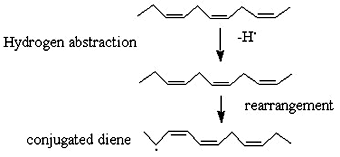
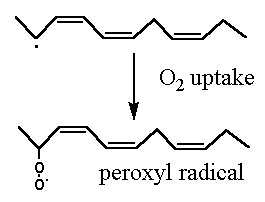
Formation of a hydroperoxide, termination, is a result of the reaction between a peroxyl radical and a-tocopherol, a lipophilic in the cell membranes. The reaction of oxygen with a carbon double bond leads to the formation of hydroperoxides. Reaction between single oxygen molecules and polyunsaturated fatty acids can be catalyzed by enzymes such as lipoxygenase and cyclooxygenase (Jeroen, Rawi and Joran 3290).
Methylation
The process of methylation involves “conjugating methyl groups to toxins” (Jeroen, Rawi and Joran 3291). The common methyl group used in detoxification is obtained from S-adenosylmethionine (SAM), which is synthesized from the amino acid group. The synthesis process demands “nutrients choline, the active form of B12 —methyl cobalamin, and the active form of folic acid —5-methyltetrahydrofolate” (Jeroen, Rawi and Joran 3291). The process of methylation leads to the inactivation and subsequent excretion of estrogens, using SAM, in a process that uses methionine to prevent estrogen-induced cholestasis.
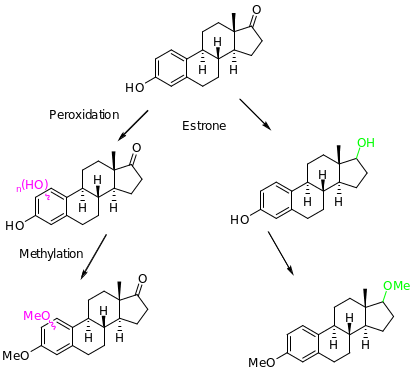
Other than methionine, there are other necessary factors for the process of methylation including: Magnesium, Folic Acid, B-12 and Methyl Donors. The methylation process is induced by Lipotropic nutrients (choline, methionine, betaine, folic acid and vitamin B12), and inhibited by a deficiency of Folic acid or vitamin B12.
Reductive amination
The chemical exploitation of glycopeptide antibiotics is aimed at identifying new clinically antimicrobial agents. Use of double cleavage linkers in the attachment of resin beads to the carboxyl functional group is effected through “randomization on the NH2 or the OH groups via acylation or reductive amination of the amino group, and acylation or alkylation of the phenol”. Amination of N-13 aids in the “combinatorial incorporation of R2 and R3 substituents obtained from chloromethylated polystyrene beads via a THP-based linker” (Jeroen, Rawi and Joran 3293). Secondary amines obtained from the reductive amination of resin bound aldehyde with primary amines can be coupled with sulfonyl chlorides after cleavage from the resin. A combination of reductive amination and safe-guarding of group adjustments helps to transform phenolic building blocks, which can then be coupled with primary alcohols.
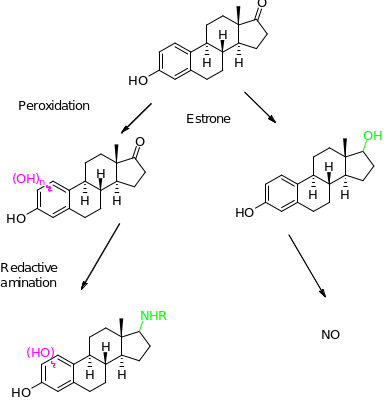
Acylation
Acylation is achieved using 1, 3-diisopropylcarbodiimide (DIPC) and acid to generate a 21-member library, such as the acylation of exocyclic amine using 5 aci chlorides.
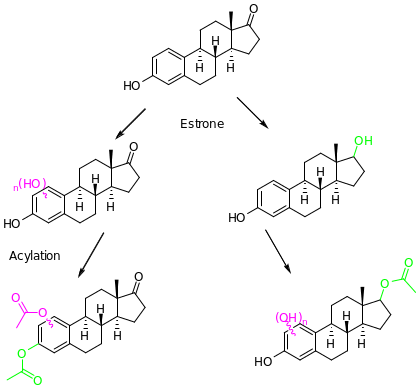
There is a wide variety of complex compounds obtained from biological systems, though only a few reactions are involved in their creation. One such reaction involves the formation of a carbon-carbon bond, in the alkylation process. The process of methylation uses methyl iodid and methyl sulphonates in the biosynthesis of secondry metabolites (Jeroen, Rawi and Joran 3289). This process is shown in the figure below.
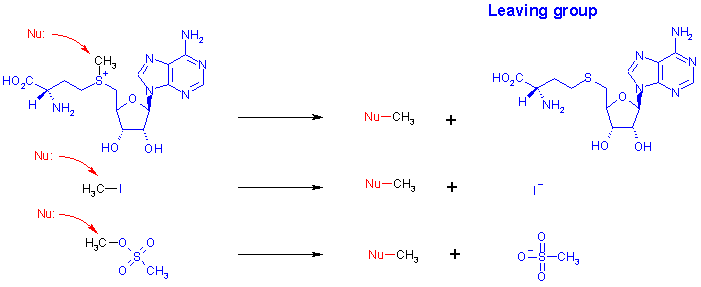
The process of transamination involves interconversion of carbonyl and amino groups, with formation of imines after the condensation of amines with aldehydes. The reaction is shown in the figure below.

“The conversion of amino acids into keto acids is a central reaction of primary and secondary metabolism”.
![]()
The discovery of unique bioactive chemical structures with drug potential is achieved by studying the evolutionary structure-activity optimization in nature. There are a variety of projects that are “focused on bioengineering of circular proteins, methods of selection, antifouling molecules from marine organisms and antitumor natural products, which are aimed at bridging chemistry and biology due to the increased interest for environmental aspects, green chemistry and a sustainable use of natural products” (Zahner, Drautz and Weber). The figure below shows the interdisciplinary nature of pharmacognosy.
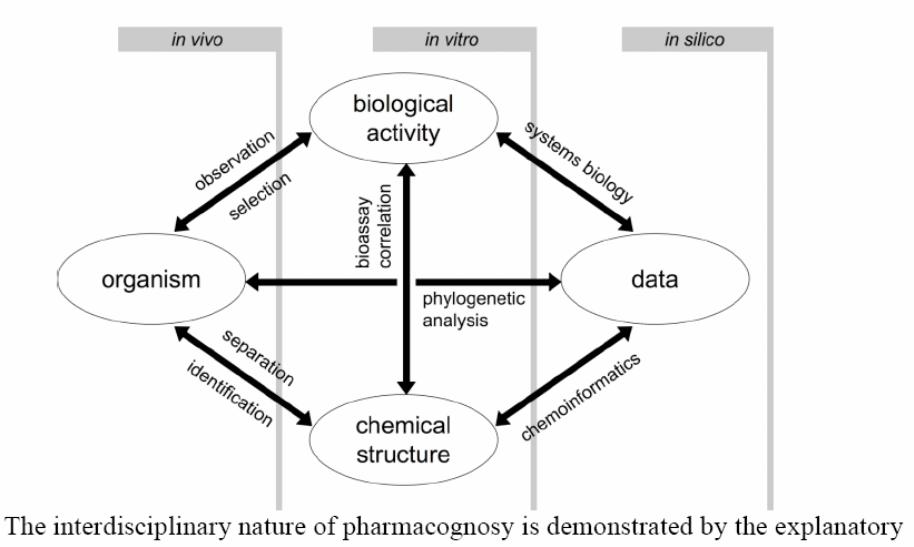
Background information
The process of developing new drug compounds involves fast dismissal of prospective mixtures, which makes it a time consuming and costly endeavour. It is for this reason that the pharmaceutical industry encourages fast and precise strategies, to identify and filter the undesirable compounds. The common screening properties include the physiochemical ones, in addition to the ADME, absorption, distribution, metabolism and excretion profiles of the compounds (Bates, Foster and Griggs 2824).
To ensure quick dismissal of unfavorable test drug compounds, pharmaceuticals have resulted in analysis of the solubility of compounds in the early stages of development of the drug. This has been a significant measure in ensuring minimal wastage of resources on appealing compounds whose poor solubility propoerties were previously discovered much later when undertaking the physiochemical tests. The importance of aqueous solubility is its ability to “predict the amount of drug compound available for intestinal absorptions.” This helps to avoid wrong development strategies for the compound, or even false results in a bioassay screening test (Bates, Foster and Griggs 2824).
Estrogenic hormones
The ovaries secrete three of these hormones, namely: “estrone, a rare hormone; estriol, prevalent during pregnancy; and estradiol, which is ever present in the body of women” (Marques, Maada and Lingeman 86). Low levels of estrone in the human body make it toxic. In addition to that, estrone has been observed to be carcinogenic and capable of enhancing growth. There are some detrimental effects of estrone, relating to reproduction, including: prevention of egg implantation; impotence and inhibition of spermatogenesis. Extrone is excreted from the body, and a lot of it is found in river waters as well as sewage effluents (Marques, Maada and Lingeman 86).
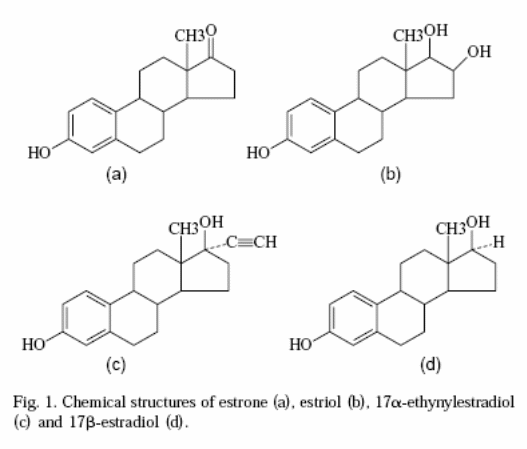
Medicinal chemistry
The production of commercial metabolites was one of the results of the discovery of penicillin fermentation. The metabolites are of two kinds, namely primary and secondary, whereby the former is a product of primary metabolism, a process that is universal among living systems, while the latter is from secondary metabolism, which is carried out by plants and microbes. The bio-industry recognizes some primary metabolites as vital. Some of the primary metabolites include purine nucleotides, amino acids, vitamins and organic acids (Hill 26).
Secondary metabolism is strain specific, and its yields are of much value to the human health, especially the microbial sources, which are discerning on their effects on pathogenic bacteria and fungi. It is for this attribute that the pharmaceutical industry has ventured extensively, in the screening of secondary metabolites, for “antibacterial, antifungal and antitumor chemotherapy, in addition to other diseases caused by organisms besides bacteria, fungi and tumors” (Hill 26).
The discovery of new antibiotics is possible through screening of microorganisms, including Bacillus, Penicillium and Streptomyces. The screening process involves the testing of pure isolates for antibiotic production. These isolates are extracted from antibiotic-producing microorganisms that occur naturally. “The tests examine the diffusible materials that are inhibitory to the test or indicator bacteria”. Additional tests are conducted on the isolates that exhibit signs of antibiotic production, with the view to determining whether the antibiotics that they produce are any different (Vlieger, Kolkman and Ampt 669).
The discovery of organisms that produce new antibiotics leads to mass production of the organism, purification and testing for cytotoxicity as well as therapeutic activity in infected animals. The medically useful antibiotics, which yield positive results in the in vivo testings, are repoduced commercially, though their concentration is known to be minimal. This makes it necessary to isolate high yielding strains, and increase the yield using strain selection and appropriate medium development. This process involves “mutagenesis of the wild type culture, screening for mutants and testing of the mutants for enhanced antibiotic production” (Vlieger, Kolkman and Ampt 669).
Separation science uses techniques such as HPLC and capillary electroseparations, on analytes of drugs, with focus on separation mechanisms, optimization with multivariate data analysis techniques and bioanalytical determinations. It is important to use effecient analytical methods in the various stages of drug discovery and development. Some of the important techniques in early drug development stages include: “purity control and substance identity in chemical libraries; high speed analysis for fast screening of drug receptor interactions and physico-chemical characterization of drug candidates” (Vlieger, Kolkman and Ampt 669).
To ensure that the pharmaceutical formulations are of the right combinations of compounds and excipients, analytical methods are implemented, especially that of drug molecules that exist in two forms, or mirror images of each other, i.e. enantiomeric drugs. This is because the enantiomerics may have antagonistic effects, whereby one is therapeutic while the other is toxic. The most vital areas in drug discovery and development are: chiral separation methods; drug solubility and dissolution; multiple injection capillary zone electrophoresis; analysis of drugs in the environment and quantitative NMR spectroscopy in pharmaceutical research (Vlieger, Kolkman and Ampt 670).
Screening process
The screening process of microorganisms and their metabolites involves a number of areas including the development and validation of assay(s). It is possible for the estimation of hit rates and large numbers of samples to be rapidly screened via the process of primary screening. This is aimed at obtaining sufficient data to propagate the full screening program. The other area is high throughput screening. This allows the screening of large numbers of potential samples, via automated systems, which use fewer steps, as well as retesting and confirmation of active metabolites from the initial screen. The third area aims at elimination of false positive results by secondary screening of the active metabolites. The active fractions at this stage are classified based on their “heat stability, chemical classes, molecular weights, pH optimum and enzyme inhibition patterns. More in vivo tests are undertaken on the potential molecules, after purification and structure elucidation (Demain and Fang 13).
Medical importance of estrogen receptor
According to Ali and Coombes, the estrogen receptor is vital in the development of breast cancer. Osteoporosis, on the other hand, is crucial in postmenopausal women. “It is for this reason that the selective estrogen receptor modulators (SERMs) are used on a large scale in the treatment and prophylaxis of the disorders”(Fura, Shu and Zhu 4340). Research has also indicated that TAM reduces the threat of breast cancer in women by about half (Fura, Shu and Zhu 4340).
Raloxifene (RAL) is used in the prevention of osteoporosis in postmenopausal women, which is especially beneficial in reducing the risk of breast cancer. “RAL also has a positive effect on the cardiovascular system by reducing levels of low-density lipoprotein-cholesterol and homocysteine” (Fura, Shu and Zhu 4340). According to Fura, Shu and Zhu (4340), most SERMs are metabolized by membrane-bound cytochrome P450 enzymes. P450s in endomerital tissue in the TAM assist in the formation of NA-reactive hyroxytamoxifen, which results in endometrial cancer. “According to Ali and Coombes, RAL is metabolized by P450s to produce three quinones with alkylating properties toward macromolecules” (Fura, Shu and Zhu 4341).
Research has indicated that the metabolites for both TAM and RAL have a high affinity for ER_. “Efficient sensitive screening methods for identifying the pharmacologically active metabolites are important since polymorphisms in P450s or drug-drug interactions at the level of P450s can result in modified pharmacological effects in humans” (Fura, Shu and Zhu 4342).
Analysis of metabolite mixtures
There are a variety of approaches used when it comes to screening intricate mixtures, including metabolic incubations. “The common strategies used for proteins include pre-column off-line, post-column off-line, at-line, and on-line strategies.” According toKool, Giera and Irth, “on-line screening systems integrate separation sciences, mass spectrometry and biochemical methodology,” to allow for screening for active compounds in complex mixtures (Marques, Maada and Lingeman 90).
“The generation of metabolites and the analysis of their mixtures are performed by off-line incubation, extraction, and HPLC separation, together with a variety of on- or off-line detection techniques” (Kool, Giera and Irth 2657). The operations in these methods are manual and take a lot of time. This necessitated new systems that could me more efficient in the formation, trapping and separation of P450 generate metabolites. This was achieved by introducing a novel bio analytical system, based on the hyphenation of a small-scale (500_1) P450 containing bioreactor to solid phase extraction (SPE) and gradient HPLC (Kool, Giera and Irth 2657).
The execution of this method together with post column bio affinity detection system resulted in metabolites that could be screened directly on selected pharmacological properties. Today, there are many high-resolution screening (HRS) detection systems available, as indicated by the recent development of the P450 inhibition and a phosphodiesterase inhibition HRS detection system (Kool, Giera and Irth 2656).
According to Kool, Giera and Irth, (2657), “Operation of these methods uses enzymatic conversion of model substrates in highly fluorescent products. A negative peak in the assay baseline is seen due to formation of less fluorescent when the reaction is repressed by substrates or inhibitors”. According to Kool, Giera and Irth, (2657), the identification of ER_-binding compounds using HRS bioaffinity assay is based on the increase of fluorescent signal of the tracer compound coumestrol when bound to the ER_ligand-binding domain. ”Coupling the P450 bioreactor to a HRS ER_ affinity detection system, allows for the screening of on-line metabolites for ER_ affinity in a postcolumn detection mode. Analysis of the detected active metabolites with LC-MS/MS helps to resolve the structural features of the metabolites” (Kool, Giera and Irth 2657).
Waste water effluent is used in studies regarding estrogens, androgens and progestins. These studies have, for example, indicated that the exposure of aquatic species to estrogens interferes with their reproduction, and also causes feminine characteristics in male fish. Some of the common compounds subjected to tests are shown below.
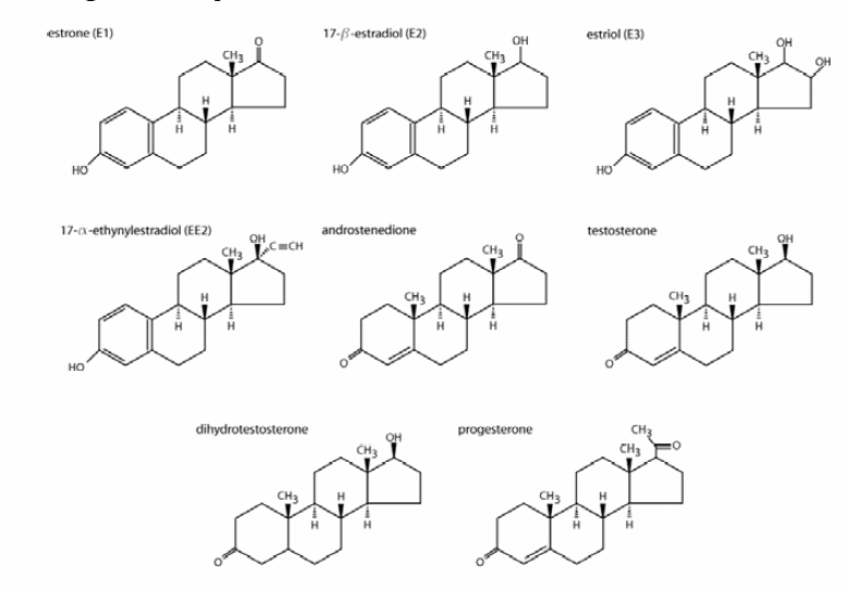

Estrogens
“Estrogens are involved in the development and maintenance of female reproductive systems as well as their secondary sexual characteristics” (Carroll, Nairne and Smith 127). Studies conducted on estrogens have indicated that its circulation “exists in a dynamic equilibrium of metabolic interconversions, and estradiol is the principal intracellular human estrogen making it substantially more potent than its metabolites, estrone and estriol, at the receptor level” (Carroll, Nairne and Smith 127).
The amounts of estrogen secreted on a daily basis range from 70 to 500 mcg. This amount is dependent on the phase of the menstrual cycle. “After menopause, most endogenous estrogen is produced by conversion of androstenedione, secreted by the adrenal cortex, to estrone by peripheral tissues” (Carroll, Nairne and Smith 127). “This implies that estrone and the sulfate conjugated form, estrone sulfate, are the most abundant circulating estrogens in postmenopausal women” (Carroll, Nairne and Smith 127).
“Estrogens act through binding to nuclear receptors in estrogen-responsive tissues” (Carroll, Nairne and Smith 127). There are two commonly know estrogen receptors, which vary in proportion from one tissue to the next. “Circulating estrogens modulate the pituitary secretion of the gonadotropins, luteinizing hormone (LH), and follicle-stimulating hormone (FSH) through a negative feedback mechanism. Estrogens act to reduce the elevated levels of these hormones seen in postmenopausal women” (Carroll, Nairne and Smith 128).
Norethindrone
Norethindrone, also refered to as norethisterone, is a progestogen used in the manufacture of hormonal contraceptives, as well as in the treatment of abnormal heavy bleeding and irregular periods. Another common use of norethindrone is to prevent uterine hemorrhage in gynecologic cases that do not involve surgery.
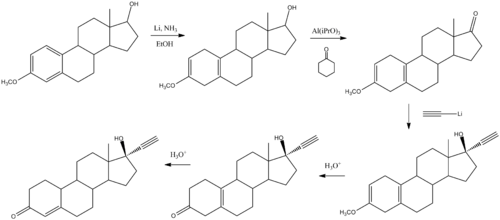
Like the acetates and enante esters, norethisterone is prepared by chemical synthesis from precursors found in the Mexican yam. Its administration is oral and intramuscular for the acetate and enanthate, respectively (Carroll, Nairne and Smith 128). Before it reaches its maximum amount in blood plasma, it is first metabolised in the liver and other enteric organs (Carroll, Nairne and Smith 128).
17β-Estradiol
This is a female “sex steroid hormone that is produced in the ovaries by the placenta during pregnancy. It is also produced in the arenal cortices, testes and peripheral tissues” (van Liempd, Kool and Reinen 207). 17β-Estradiol hormone is synthesized enzymatically from acetate, cholesterol, progesterone and testosterone. Estradiol is known to cause anatomic and physiological manipulation of reproduction and secondary sex characteristics. In addition to this, it affects activities such as bone growth, brain development and maturation, and the intracellular concentration of calcium6 and certain second messenger molecules (van Liempd, Kool and Reinen 207).
“Estradiol (E2) is a white crystalline powder with a chemical name of “estra-1, 3, 5 (10)-triene-3, 17β-diol hemihydrate with the empirical formula of C18H24O2, 1⁄2 H2O. It has a molecular weight of 281.4” (van Liempd, Kool and Reinen 208). Estradiol can be absorbed via the gastrointestinal tract when ingested orally in tablets, and its concentration in blood rises slowly as it is metabolized to estrone sulfate (van Liempd, Kool and Reinen 208).
Progestins
“The progestin compounds enhance cellular differentiation to counter the actions of estrogens by reducing the receptor levels of estrogen, increasing local metabolism of estrogens to less active metabolites, or inducing gene products that blunt cellular responses to estrogen” (van Liempd, Kool and Reinen 208). “Progestins exert their effects in target cells by binding to specific progesterone receptors that interact with progesterone response elements in target genes” (van Liempd, Kool and Reinen 209). “Progesterone receptors have been identified in the female reproductive tract, breast, pituitary, hypothalamus, and central nervous system. Progestins produce similar endometrial changes to those of the naturally occurring hormone progesterone” (van Liempd, Kool and Reinen 209).
Oxprenolol
Oxprenolol is a non-selective beta blocker used in the treatment of anxiety and hypertension among others. It exhibits intrinsic sympathometic activity, and has the ability to pass the blood-brain barrier with more ease as compared to water soluble beta blockers. The usage of oxyprenolol is restricted to asthmatic people due to the possibility of irremediable airway failure and inflammation (van Liempd, Kool and Reinen 209).
Oxprenolol is used in the treatment of heart conditions and high blood pressure, since it is a lipophilic non-selective beta blocker that easily passes the blood-brain barrier, leading to CNS-related side effects (van Liempd, Kool and Reinen 209).
Oxprenolol behaves in a manner similar to other beta-adrenergic antagonists, in that it competes for biding at sympathetic receptor sites with adrenergic neurotransmitters. Oxyprenolol binds at beta (1)-adrenergic receptors in the heart and vascular smooth muscle, in a manner similar to propanolol and timolol. In doing so, it “inhibits the effect of the catecholamines epinephrine and norepinephrine and decreasing heart rate, cardiac output, ad systolic and diastolic blood pressure” (van Liempd, Kool and Reinen 210).
Oxyprenolol blocks “beta-2 adrenergic receptors located in bronchiole smooth muscle, causing vasoconstriction” (van Liempd, Kool and Reinen 210). It also inhibits the production of renin, by binding beta-2 receptors in the juxtaglomerular apparatus. This limits the production of angiotensin II and aldosterone, and “inhibits the vasoconstriction and water retention due to angiotensin II and aldosterone, respectively” (van Liempd, Kool and Reinen 210).
Tamoxifen
Estrogenic metabolites in tamoxifen can be identified via HRs-ERR technology. “Tamoxifen is a nonsteroidal antiestrogen used in hormonal therapy of human breast cancer”. It is used extensively in the prevention of cancer in women through chemotherapy. According to research that has been conducted on tamoxifen, it has been observed that it is metabolized by “cytochrome P450s (Cyt P450s)5 and Flavin-containing Monooxygenases (FMOs)6 to multiple mono- and dihydroxylated and N-demethylated derivatives” (Demain and Fang).
The table below shows some of the most vital primary and secondary metabolites of tamoxifen.

Table 1: structures of tamoxifen and primary and secondary metabolites.
In a test conducted on tamoxifen, the on-line assay is used to identify estrogenic activity, using the association between the estrogen receptor and the native fluorescent ligand coumestrol. The latter is especially useful as it shows fluorescence enhancement when it is bound to the active site of the ER. The process involves the injection of estrogenic analytes in the HRS-system, which then bind to the ER. The ER binding sites that are unattached attract coumestrol, which leads to a profound fluorescence enhancement based on the eluting estrogenic analytes that are already bound. This presents a suitable way of identifying bioactive compounds. The ability to clearly examine the metabolic profile in full with the consequent bioactive metabolites results in clear shots of the significance of ER affinities of singular metabolites in time. This is possible by virtue of the sensitive, selective and fast analysis process (Shinya, Takeshi and Etsuko 7902).
Conclusion
The typical process of bio affinity assessment of mixtures involves fractionation, evaporation of the fractions and the identification of bioactive fractions using micro plate bioassays, which are carried out in parallel with compound identification by mass spectrometry or nuclear magnetic resonance (NMR) spectroscopy. The procedure has a few drawbacks including difficulties in accurately matching the dereplicated bioactive compounds, especially matching the fractions to their chemical structure. Typical examples include “fractionation of intact proteins before matrix-assisted laser desorption ionization (MALDI) MS analysis [10], and many types of biochemical assay formats that are conducted after fractionation of bioactive mixtures, such as natural extracts, metabolic mixtures, and environmental mixtures” (Marques, Maada and Lingeman 90).
Another significant drawback is the high resolution obtained from the separation step that disappears in the low-resolution fractionation process. The advances in the science of separation have increased research into adjusted or newly designed bioassay formats. An alternative to HTS is the direct on-line post-column coupling of a bioassay to a chromatographic separation. The HRS process requires fast and direct on-line bioassays in order to achieve high resolution and sensitivity, whose systems operations are based on UV and fluorescence detection (Marques, Maada and Lingeman 90).
High-resolution screening
The large variety of biological targets and assays have been transformed into on-line and at-line bioassays with direct coupling to separation for mixture analysis. Other formats for bioassay involve pre-column and on-column techniques. The hyphenated screening methods are able to provide comprehensiv bioaffinity information with correlated compound identities, though the traditional techniques come into play once the bioactive compounds are identified. This is because the hyphenated screening approaches are not sufficient in the following procedures that involve purification and synthesis of the bioactive compounds (Yarborough, Taylor and Rowlands 539).
According to research conducted, there are three main reasons as to why the HRS-based identifiction techniques of bioactive compounds are followed by traditional approaches. The first is that a large number of research facilities are adapted to traditional and integrated workflows of analyzing pure compounds from the hit stage to the lead development phase. The second reason is that the advances in more traditional screening enable elaborate and comprehensive “high content” analysis of single compounds that hyphenated bioassay-analytical screening methods can not yet compete with. The third reason is that traditional techniques are applicable to a wider range of assays, from easy ligand-binding bioassays to high-content cellular biological assays with multiple readouts (Yarborough, Taylor and Rowlands 539).
In spite of the requirement for traditional approaches, HRS and the related techniques are vital in identifying bioactive compounds, and repliction of bioactive mixtures. The development of HRS strategies allow for the fast and convenient profiling of bioactive mixtures, as seen in the incorporation of drug target classes in on-line screening processes. Other aropriate exmples are enzymes that are able to rapidly convert substrates into fluorescent products and receptors for which ligands are available that show fluorescence enhancement in the binding pocket (Yarborough, Taylor and Rowlands 539).
On-line MS-based bioassays or at-line screening methods are good options for other enzyme and receptor drug targets, as in the case for “bioassay formats for which only native substrates or ligands are available, bioassays that demand long incubation times, and other difficult bioassay formats, such as those involving membrane-bound drug targets and cellular assay formats” (Yarborough, Taylor and Rowlands 539).
On-line high resolution screening
The metabolism of endogenous compounds and xenobotics is highly dependent on the biotransformation enzymes. It is not uncommon for metabolites to exhibit a strong attraction to macromolecules and receptors, like tamoxifen, which is used in hormonal therapy of human breast cancer. To facilitate the detection of singular ligands in intricate blends while observing their biological activity, High Resolution Screening (HRS) is used. HRS uses continous flow biochemical detection assays together with High Performance Liquid Chromatography (HPLC). The figure below shows the schematic view of the HRS setup (Marques, Maada and Lingeman 87).
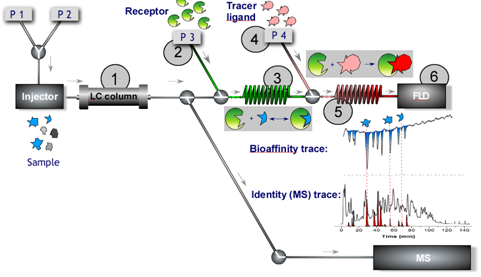
Works Cited
Bates, D. J., et al. “Devleeshouwer, N. Metabolism of tamoxifen by isolated rat hepatocytes: anti-estrogenic activity of tamoxifen N-oxide.” Biochem.Pharmacol. (1982): 31 (17), 2823-7.
Carroll, M. A., et al. J. Fluorine Chem. (2007): 128, 127-132.
Demain, A L and A Fang. “The natural functions of secondary metabolites.” Advances in Biochemical Engineering Biotechnology (2000): 69, 1-39.
Fura, A., et al. “Discovering drugs through biological transformation:role of pharmacologically active metabolites in drug discovery.” J. Med. Chem. (2004): 47 (18), 4339-51.
Hill, D. C. “Advanced screenng technology and informatics for natural products drug discovery.” Advances in Drug DiscoveryTechniques (1998): 25-37.
Kupfer, D. “Metabolism of the antimammary cancer antiestrogenic agent tamoxifen. I. Cytochrome P-450-catalyzed N-demethylation and 4-hydroxylation.” Drug Metab. Dispos (1993): 21 (4), 645-56.
Jeroen, Kool, et al. “Rapid On-line Profiling of Estrogen Receptor Binding Metabolites of Tamoxifen.” J. Med. Chem. (2006): 49, 3287-3292.
Kool, Jeroen, et al. “Advances in mass spectrometry-based post-column bioaffinity profiling of mixtures.” Anal Bioanal Chem (2011): 399, 2655–2668.
Li Zhilan, Wang Shuo, Alice Lee, Robin Allan, Ivan R. Kennedy. “Development of a solid-phase extraction—enzyme-linked immunosorbent assay method for the determination of estrone in water.” Analytica Chimica Acta 503 (2004): 171-177.
Lim, C. K., et al. “Identification and mechanism of formation of potentially genotoxic metabolites of tamoxifen: study by LC-MS/MS.” J. Pharm. Biomed. Anal. (1997): 15 (9-10), 1335-42.
Marques, Lygia Azevedo, et al. “Stability-indicating study of the anti-Alzheimer’s drug galantamine hydrobromide.” Journal of Pharmaceutical and Biomedical Analysis (2011): 55, 85-92.
Rao, Pemmaraju N. and James W. Cessac. Steroids (2002): 67, 1065-1070.
Shinya, Sato, et al. “One-pot reductive amination of aldehydes and ketones with a-picoline-borane in methanol, in water, and in neat conditionsq.” Tetrahedron (2004): 60, 7899–7906.
van Liempd, S. M., et al. “On-line Formation, Separation, and Estrogen Receptor Affinity Screening of Cytochrome P450-Derived Metabolites of Selective Estrogen Receptor Modulators.” Drug Metabolism and Disposition (34 (9),1640–1649): 2006.
van Liempd, S. M., et al. “Development and validation of a microsomal online cytochrome P450 bioreactor coupled to solid-phase extraction and reversed-phase liquid chromatography.” J Chromatogr (2005): 1075:205–212.
Vlieger, Jon, et al. “Determination and identification of estrogenic compounds generated with biosynthetic enzymes using hyphenated screening assays, high resolution mass spectrometry and off-line NMR.” Journal of Chromatography B (2010): 878, 667–674.
Wang, Bijia, et al. Supporting Information for Improved Arene Fluorination Methodology for I(III) Salts. Lincoln, NE: University of Nebraska, 2008.
Yarborough, G., et al. “Screening microbial metabolites for new drugs-theoretical and practical issues.” J. Antibiotics (1993): 46, 535-544.
Zahner, H., H. Drautz and W. Weber. Novel aproaches to metabolite screening in: Bioactive Microbial Products. London, UK: Academic Press Inc., 1982.